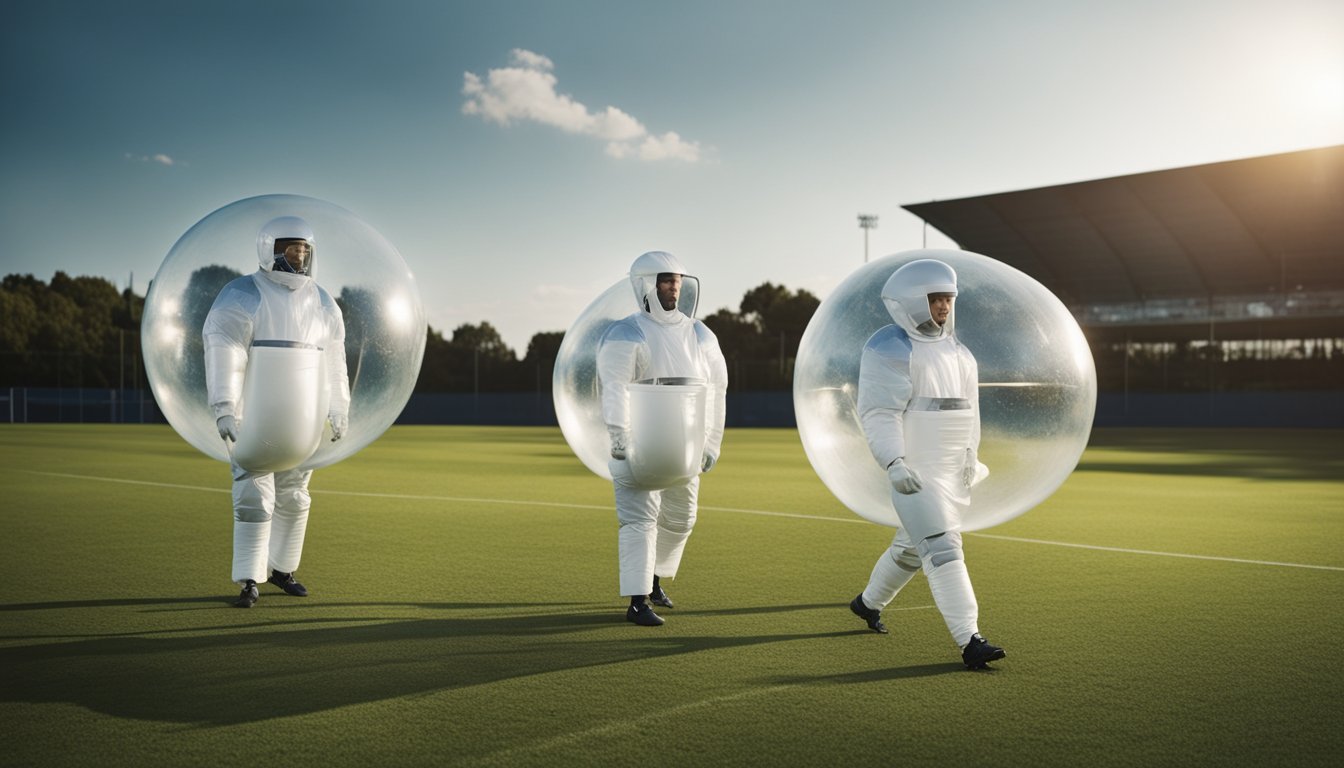Late updated: 11 Aug 2024 08:08
Written by: Emma Saunders
The Environmental Impact Of Bubble Football: Assessing The Ecological Footprint Of This Growing Sport
Bubble football, an exhilarating twist on the traditional game, has surged in popularity in recent years. Involving players running around in large inflatable bubbles, this sport attracts those seeking both fun and physical activity. Yet, the environmental impact of bubble football is an important concern that deserves our attention. From the production of the inflatable bubbles to the organisation of events, every facet of this sport contributes to its environmental footprint.

The production of bubble football equipment, primarily made from plastic materials, raises questions about sustainability and waste. Factories that manufacture these inflatables may use significant energy and resources, adding to carbon emissions and plastic waste. Additionally, hosting bubble football events can involve transporting equipment and participants, further increasing the carbon footprint linked to this activity.
Fortunately, there are sustainable practices that can mitigate some of these environmental effects. By choosing eco-friendly materials for equipment and promoting local events to reduce travel distances, we can enjoy bubble football while lessening its impact on our planet. Exploring these avenues not only helps the environment but also sets a positive example for how sports can evolve responsibly.
Key Takeaways
- Bubble football has environmental impacts tied to equipment production and events.
- Sustainable practices can reduce the sport's carbon footprint.
- Our responsibility is to enjoy the sport while considering its environmental effects.
Environmental Challenges Faced by Football
Football, while beloved globally, presents significant environmental challenges. These challenges include a substantial carbon footprint, the role of major organisations, and the direct impacts of climate change on the sport.
Carbon Footprint of the Football Industry
The football industry significantly contributes to carbon emissions. The construction and maintenance of stadiums require vast amounts of energy and materials. Moreover, large-scale events such as the FIFA World Cup and European football tournaments draw millions of fans, generating substantial emissions from travel and hospitality services.
Energy consumption within stadiums is another significant contributor. Floodlights, heating, and cooling systems all rely heavily on electricity. Switching to renewable energy sources is one way clubs are attempting to mitigate this impact. Nevertheless, we must consider the emissions generated by teams and fans travelling internationally for matches, adding to the cumulative carbon footprint.
The Role of Major Football Organisations
FIFA, UEFA, and national bodies such as The FA play crucial roles in addressing football's environmental impact. These organisations have started to implement sustainability initiatives, like the UN Sports for Climate Action Framework, which commits signatories to reducing carbon emissions and promoting climate awareness.
Football clubs are also increasingly incorporating sustainable practices. For instance, some clubs are investing in solar panels and energy-efficient technologies. Forest Green Rovers, a club in League Two, is recognised for its environmentally friendly initiatives, serving as a model for other clubs. Major tournaments are also beginning to adopt sustainable practices, yet the overall progress remains inconsistent across the industry.
Impact of Climate Change on Football
Climate change poses direct threats to football. Extreme weather events, such as flooding and heatwaves, disrupt matches and damage infrastructure. Rising temperatures can affect player performance and increase the risk of heat-related illnesses. This is particularly pronounced in countries with warm climates where football is immensely popular.
Football authorities are beginning to adapt by revising schedules and improving stadium resilience. However, more comprehensive strategies are required to tackle these persistent issues. Addressing climate change within football isn't merely about mitigating future risks but also about ensuring the sport's sustainability in an increasingly unpredictable climate.
Incorporating sustainability into football's ethos is imperative. From grassroots initiatives to major league adaptations, every level plays an essential role in mitigating football's environmental challenges. As we move forward, continuous efforts from both organisations and individuals are needed to safeguard our planet while enjoying the beautiful game.
Sustainable Practices in Football

As the global focus on sustainability grows, the football industry is adopting various eco-friendly practices. These efforts span across innovations in infrastructure, effective mitigation strategies, and engaging communities and fans.
Innovations in Eco-friendly Infrastructure
Football clubs are increasingly using renewable energy sources to power their stadiums. For instance, the Forest Green Rovers stadium is entirely powered by wind and solar energy. Efforts like these contribute significantly to reducing the overall carbon footprint of football events.
In addition, the use of recycled materials in the construction and renovation of stadiums helps minimize waste. Many clubs are also investing in energy-efficient lighting and water-saving technologies, further promoting sustainable development.
Mitigation and Adaptation Efforts
To combat climate change, football clubs are engaging in various mitigation and adaptation efforts. Initiatives like We Play Green, founded by Morten Thorsby, focus on reducing carbon emissions and promoting responsible practices. Clubs like Union Berlin are committing to carbon neutrality by offsetting their emissions through various programs.
Another important strategy is the reduction of single-use plastics in stadiums. By encouraging the use of reusable cups and containers, clubs not only reduce waste but also set a positive example for fans. Additionally, the promotion of public transport to matches reduces traffic congestion and emissions.
Community and Fan Engagement
Engaging the community and fans in sustainable practices is crucial for the success of these initiatives. Organisations like Football for Future are working at the grassroots level to educate fans about sustainability and their role in it. Non-league and smaller clubs are also getting involved, promoting localised efforts for a broader impact.
Supporter responsibility plays a significant role, as fans are encouraged to adopt eco-friendly behaviours, such as using public transport and participating in waste reduction programmes. By fostering a culture of sustainability, football clubs can inspire broad societal change beyond the sport itself.
Frequently Asked Questions

Understanding the environmental impact of bubble football requires looking at the materials used, the life cycle of the equipment, and their carbon footprints. Additionally, integrating environmental education into sports can help address these impacts.
What materials are used in the manufacturing of soccer balls, and how do they affect the environment?
Most soccer balls are made from synthetic leather, rubber, and various plastics. These materials are derived from petroleum, contributing to pollution and resource depletion. The production process involves chemicals that can harm ecosystems if not managed properly. Choosing eco-friendly materials can mitigate these effects.
How does the life cycle of a football contribute to climate change?
The life cycle of a football—spanning manufacturing, usage, and disposal—emits greenhouse gases at multiple stages. Manufacturing requires energy, often from fossil fuels, contributing to carbon emissions. Disposal can lead to landfill waste, releasing methane, a potent greenhouse gas. Extending the lifespan of footballs through reuse can reduce this impact.
What is the carbon footprint associated with different sporting events, including soccer?
Sporting events, such as football matches, have significant carbon footprints due to travel, energy consumption, and waste generation. Stadium lighting, heating, and spectator travel contribute heavily to emissions. Mitigation strategies include using renewable energy and promoting public transport.
In what ways can environmental education be integrated into sports for children?
Environmental education can be integrated into children's sports through eco-friendly practices like recycling and reducing waste. Coaches can teach the importance of sustainability, perhaps even incorporating activities like local clean-up events. This helps instil environmental responsibility from a young age.
Are there significant environmental concerns associated with the widespread popularity of football?
The wide popularity of football leads to mass production and consumption of equipment, increasing environmental strain. High demand results in more resource extraction and waste. Promoting sustainable practices within the sport can help address these concerns.
How does the production and disposal of soccer equipment influence ecological sustainability?
Production and disposal of soccer equipment impact ecological sustainability through resource use and waste generation. Sustainable production methods and materials can lessen this burden. Proper disposal, recycling, and encouraging a circular economy for sports gear can help promote ecological balance.
